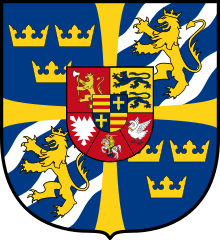
The Holstein Party (Swedish : Holsteinska partiet), was the name of a political group in 18th-century Sweden which played a significant role in politics after the death of Charles XII of Sweden in 1718 and until 1727.

The Holstein Party (Swedish : Holsteinska partiet), was the name of a political group in 18th-century Sweden which played a significant role in politics after the death of Charles XII of Sweden in 1718 and until 1727.
The party was created in 1718 of those who favored Charles Frederick, Duke of Holstein-Gottorp, son of Charles XII’s elder sister Hedvig Sophia of Sweden, as heir to the throne before that of Ulrika Eleonora, Queen of Sweden.
The party lost to the followers of Ulrika Eleonora in 1719, and to her spouse and successor Frederick I of Sweden in 1720. But due to Frederick I’s plans to strengthen royal power with support of the Hovpartiet , the Holstein Party were given a favorable situation have Charles Frederick appointed heir to the throne, a situation which was supported by Tsar Peter the Great of Russia who wished influence in Sweden.
In the Riksdag of 1723, the attempt of the king and Hovpartiet to introduce absolute power was crushed and the Holstein Party, whose follower filled the seats of parliament and bought more followers by granting allowances and titles from Holstein and Russia, especially to those losing their property during the Great Northern War: Charles Frederick was granted the title Royal Highness, a Swedish allowance and an informal promise to be considered as heir to the throne should such an election be necessary. The marriage of Charles Frederick to the Russian princess Anna Petrovna and the accession of her mother as Empress Catherine I of Russia in 1725 signified a triumph for the Holstein Party: the rumours that Charles Frederick was about to be appointed Russian heir to the throne or at least be granted the Baltic provinces made him an attractive heir to the Swedish throne by those in Sweden wishing to restore the Swedish Empire, and ambassador Josias Cederhielm was sent to Russia. These plans were however prevented by Arvid Horn with support of the king and the ambassadors of France and Great Britain to prevent Sweden from being involved in a war through Russia's promise to reconquer Slesvig to Holstein from Denmark.
During the Riksdag of 1726-1727, Horn managed to have the Riksdag vote for Sweden to join the Treaty of Hanover (1725) against Russia, and the Holstein followers was removed from the royal council and replaced with the followers of Horn. The defeat of the Holstein Party was completed by the death of Catherine I, which destroyed the power base of Charles Frederick in Russia and forced him to leave for Holstein.

AdolfFrederick was King of Sweden from 1751 until his death in 1771. He was the son of Christian August of Holstein-Gottorp, Prince of Eutin, and Albertina Frederica of Baden-Durlach. He was an uncle of Catherine the Great and husband to Louisa Ulrika of Prussia.

Frederick I was King of Sweden from 1720 until his death, having been prince consort of Sweden from 1718 to 1720, and was also Landgrave of Hesse-Kassel from 1730. He ascended the throne following the death of his brother-in-law absolutist Charles XII in the Great Northern War, and the abdication of his wife, Charles's sister and successor Ulrika Eleonora, after she had to relinquish most powers to the Riksdag of the Estates and thus chose to abdicate. His powerless reign and lack of legitimate heirs of his own saw his family's elimination from the line of succession after the parliamentary government dominated by pro-revanchist Hat Party politicians ventured into a war with Russia, which ended in defeat and the Russian tsarina Elizabeth getting Adolf Frederick of Holstein-Gottorp instated following the death of the king. Whilst being the only Swedish monarch called Frederick, he was Frederick I of Hesse-Kassel and thus Frederick I also of Sweden, though other Swedish monarchs with non-repeating names had not been enumerated.

Ulrika Eleonora or Ulrica Eleanor, known as Ulrika Eleonora the Younger, reigned as Queen of Sweden from 5 December 1718 until her abdication on 29 February 1720 in favour of her husband Frederick. Following her husband's accession as King Frederick I, Ulrika Eleonora served as his queen consort until her death in 1741.

The monarchy of Sweden is centred on the monarchical head of state of Sweden, by law a constitutional and hereditary monarchy with a parliamentary system. There have been kings in what now is the Kingdom of Sweden for more than a millennium. Originally an elective monarchy, it became a hereditary monarchy in the 16th century during the reign of Gustav Vasa, though virtually all monarchs before that belonged to a limited and small number of political families which are considered to be the royal dynasties of Sweden.
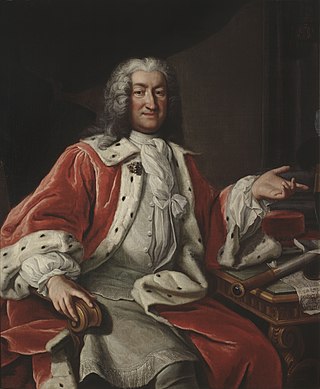
Count Arvid Bernhard Horn af Ekebyholm was a Swedish general, diplomat and politician, a member of the noble Horn family. He served twice as president of the privy council chancellery and was one of the leading figures of the Swedish Age of Liberty.
In Swedish and Finnish history, the Age of Liberty was a period that saw parliamentary governance, increasing civil rights, and the decline of the Swedish Empire that began with the adoption of the Instrument of Government in 1719 and ended with Gustav III's self-coup in 1772. This shift of power from the monarch to parliament was a direct effect of the Great Northern War.
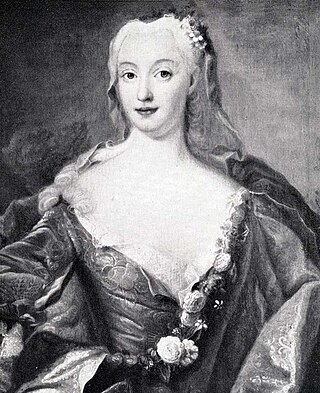
Hedvig Ulrika Taube, also Countess von Hessenstein, was a Swedish courtier and countess, a countess of the Holy Roman Empire, and royal mistress to king Frederick I of Sweden from 1731 to 1744. She and Sophie Hagman are the only two official royal mistresses in Swedish history.

Hedvig Sophia Augusta of Sweden, Duchess of Holstein-Gottorp, was the eldest child of Charles XI of Sweden and Ulrike Eleonore of Denmark. She was heiress presumptive to the Swedish throne from her birth until that of her brother one year later and again from the start of his reign as King of Sweden, in 1697, until her death and the regent of the duchy of Holstein-Gottorp for her minor son from 1702 to 1708. Some sources refer to her as Sofia.
The Hats were a Swedish political faction active during the Age of Liberty (1719–1772). Their name derives from the tricorne hat worn by officers and gentlemen. They vied for power with the opposing Caps party. In 18th century Swedish politics, the Hats represented conservatives, the Caps represented liberals. The Hats, who ruled Sweden from 1738 to 1765, advocated an alliance with France and an assertive foreign policy, especially towards Russia. During their tenure, they involved Sweden in two expensive and disastrous wars, in the 1740s and 1750s.

Louisa Ulrika of Prussia was Queen of Sweden from 1751 to 1771. She was married to King Adolf Frederick and she was queen mother during the reign of King Gustav III.

Charles Frederick, Duke of Schleswig-Holstein-Gottorp was a Prince of Sweden and Duke of Schleswig-Holstein-Gottorp and an important member of European royalty. His dynasty, the Dukes of Schleswig-Holstein-Gottorp, were a cadet branch of the ancient House of Oldenburg, which at that time was ruling Denmark-Norway. His mother was a sister of Charles XII of Sweden. Charles Frederick married a daughter of Peter the Great and became the father of the future Peter III of Russia. As such, he is the progenitor of the Russian imperial house of Holstein-Gottorp-Romanov and the patrilineal ancestor of all Russian emperors starting with Peter III, except for Catherine II.

Hedwig Eleonora of Holstein-Gottorp was Queen of Sweden from 1654 until 1660 as the wife of King Charles X Gustav. She served as regent during the minority of her son, King Charles XI, from 1660 until 1672, and during the minority of her grandson, King Charles XII, in 1697. She also represented Charles XII during his absence in the Great Northern War from 1700 until the regency of her granddaughter Ulrika Eleonora in 1713. Hedwig Eleonora was described as a dominant personality, and was regarded as the de facto first lady of the royal court for 61 years, from 1654 until her death.
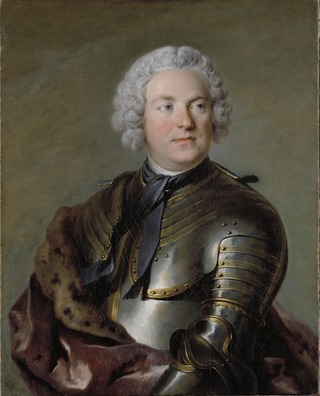
Count Carl Gustaf Tessin was a Swedish Count and politician and son of architect Nicodemus Tessin the Younger and Hedvig Eleonora Stenbock. He was one of the most brilliant personages of his day, and the most prominent representative of French culture in Sweden. He was also often considered a fine orator.

Countess Catherine Opalińska, was by birth member of House of Opaliński, Queen consort and Grand Duchess consort of the Polish–Lithuanian Commonwealth twice and Duchess consort of Lorraine through her marriage with Stanisław I of Poland and Lithuania.

Events from the year 1723 in Sweden.

Events from the year 1718 in Sweden
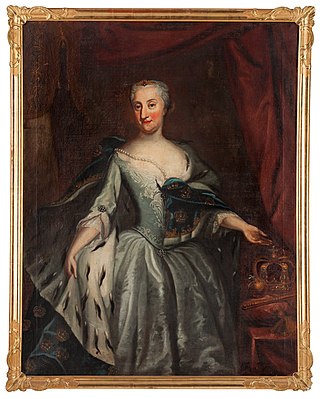
Events from the year 1719 in Sweden
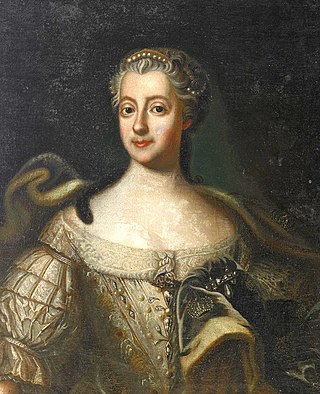
The Coup of 1756 was an attempted coup d'état planned by Queen Louisa Ulrika of Sweden to abolish the rule of the Riksdag of the Estates and reinstate absolute monarchy in Sweden. The attempted coup was exposed and subdued in 1756 shortly before it was due to be put in action. It caused a rift between the royal house and the parliament.

Hovpartiet was the name for a political group in Sweden during the Age of Liberty. Its stated objective was to strengthen the influence and power of the monarchy vice the Riksdag of the Estates. It is most known in history as the force behind Queen Louisa Ulrika's Coup of 1756, but it did in fact exist in some form or another from 1723 until Gustav III's Revolution of 1772, when its unstated objective of reinstating an absolute monarchy was finally realized.

December Crisis (1768) was a political crisis which occurred in Sweden in December 1768 when Adolf Frederick, King of Sweden, demonstrated against his limited powers by refusing to sign state documents, thereby paralyzing the government and bringing about a new Riksdag of the Estates.